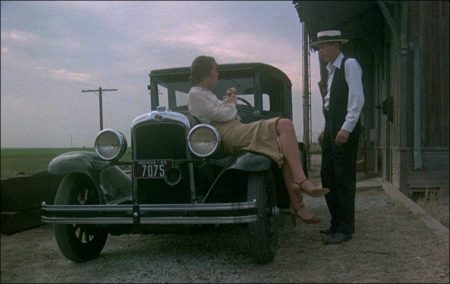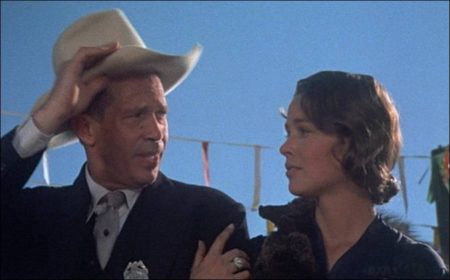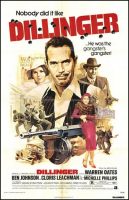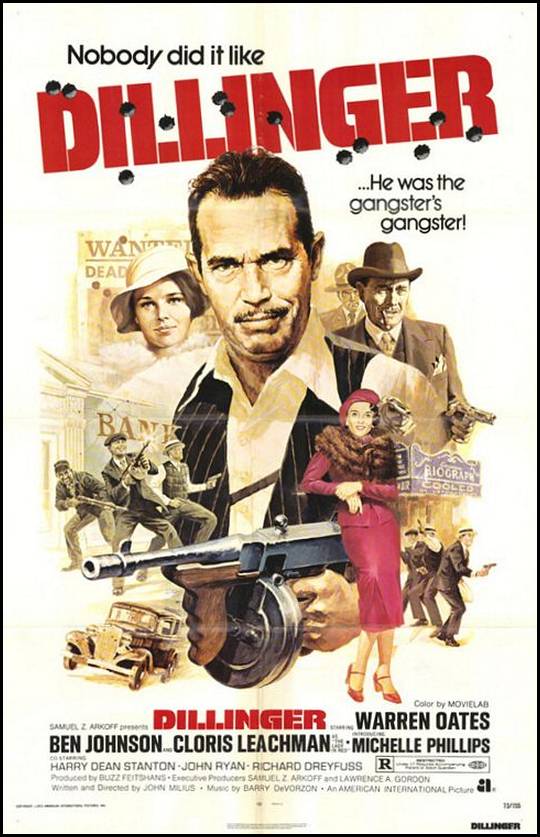Taglines: He was the gangster’s gangster!
Dillinger movie storyline. Indiana, 1933. During the Great Depression, various bank robbers and other outlaws have become folk heroes due to public distrust of financial institutions and the law. Following the Kansas City Massacre in June 1933 in which several law enforcement offers were killed brazenly in broad daylight, FBI field office chief Melvin Purvis decides to personally hunt down the men he deems responsible: Charles Arthur “Pretty Boy” Floyd, Lester “Baby Face” Nelson, George “Machine Gun” Kelly, “Handsome” Jack Klutas, Wilbur Underhill and John Dillinger. During a meeting with fellow FBI agent Samuel Cowley, Purvis makes it clear he seeks personal vengeance and that he’s willing to use extralegal measures if necessary.
Dillinger is in the midst of his criminal career, accompanied by Homer Van Meter, Harry Pierpont, Charles Mackley and others and is very boastful about his exploits. He meets Billy Frechette at a bar and immediately takes a liking to her, but becomes nonplussed when she doesn’t recognized him and robs the bar patrons to impress her. She becomes his lover, accompanying him and his gang on their exploits. During one robbery in East Chicago, the gang loses Mackley and several others, forcing the gang to scatter.
It is during this time that Purvis has begun his purge of the gangsters, hunting down and killing Underhill and Klutas and capturing Kelly. He’s unable to move against Dillinger and the others as they have not violated federal laws yet. While lying low in Arizona with the rest of the gang, Dillinger is captured by the local authorities and transported to Crowne Point, Indiana. While imprisoned there, Dillinger makes a daring escape after carving a bar of soap into the shape of a gun and fooling the guards into releasing him. It is during this escape that Dillinger finally commits a federal crime, driving a stolen car across state lines.
He takes a fellow prisoner Reed Youngblood with him, and they eventually meet back up with the gang, including new members Nelson and Floyd. They start a crime spree across the Midwest to the chagrin of Purvis, angry and jealous of the how the media romanticizes their exploits. The gang’s luck runs out following a bank robbery in Mason City, Iowa, which leads to a violent shootout ending in Youngblood’s death and the wounding of another member.
While staying at the Little Bohemia lodge in Wisconsin following the heist, Purvis leads a team of FBI agents on a raid of the lodge, costing numerous agents’ lives and sending the gang scattering again. During this chaos, Pierpont, Nelson, Van Meter and Floyd are all hunted down by either federal agents or local vigilantes and summarily killed.
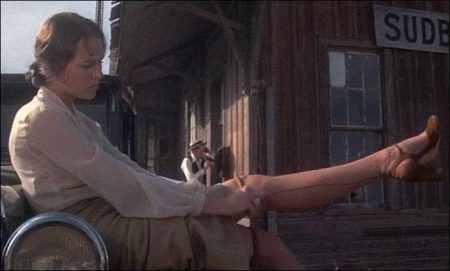
About the Production
In the early 1970s, John Milius was one of the most sought after screenwriters in Hollywood, selling his scripts for Jeremiah Johnson and The Life and Times of Judge Roy Bean for record sums. He was unhappy with the way both films turned out, however and wanted to turn director. He approached Samuel Z. Arkoff of AIP with the offer of writing a script “for a fraction of his usual price” if he could direct.
Milius says AIP gave him three choices – Blacula, Black Mama, White Mama or “a gangster thing with Pretty Boy Floyd or Dillinger. I looked at the gangsters of the early thirties and the one that had the most appeal was Dillinger. It was a subject I never would have chosen myself but it allowed me to show how good I could do a gunfight. It was a showcase to show everyone I could make it cut together, make the story hold and make the actors act.”
The project was announced in April 1972. “My father always predicted I would wind up in San Quentin by the age of 21,” said Milius. “I wouldn’t want to disappoint him too much. So here I am… directing a film about John Dillinger, the greatest criminal that ever lived.”
Milius cast Warren Oates in the lead. Milius had wanted Oates to play the lead role in The Life and Times of Judge Roy Bean. “I write all my things for Warren Oates or young John Wayne types,” he said. “Or sometimes Clint Eastwood. He looks good holding a gun. But to me John Wayne is the ultimate American hero. Not because he’s big and tough but because he’s sentimental. My pictures are sentimental, idealistic. I deal with values of friendliness and courtliness and the family and chivalry and honour and courage – not just guts but bigger than life courage. Nobody today writes movies in the style that I do. Nobody. I write characters that are strong and direct, superindividuals. The people in my movies fear no one but God.”
Filming took place in late 1972. Dillinger was filmed in its entirety in Oklahoma. Much use of various local landmark buildings were used in the filming from Jet, Nash, Jefferson, and Enid, Oklahoma in the North, to Ardmore, the Chickasaw Lake Club which served as Dillinger’s “Little Bohemia” Wisconsin hideout, and the old iron truss bridge near Mannsville, Oklahoma in the south, the Skirvin Tower ballroom, and the Midwest Theater in downtown Oklahoma City, filling in as the Biograph. The house at the end of the movie was filmed in Dougherty, Oklahoma.
Many local would-be actors wound up immortalized on film, such as the warden of the prison, who was in real life, an Enid, Oklahoma postman. “It’s my first time as director and I think I did an excellent job because I had such a superb script,” said Milius.
Dillinger (1973)
Directed by: John Milius
Starring: Warren Oates, Ben Johnson, Cloris Leachman, Michelle Phillips, Harry Dean Stanton, John Ryan, Richard Dreyfuss, Steve Kanaly, John Martino, Roy Jenson, Read Morgan
Screenplay by: John Milius
Cinematography by: Jules Brenner
Film Editing by: Fred R. Feitshans Jr.
Costume Design by: Charles Pierce
Art Direction by: Trevor Williams
Music by: Barry DeVorzon
MPAA Rating: None.
Distributed by: American International Pictures
Release Date: June 19, 1973 (Dallas, TX)
Views: 236
